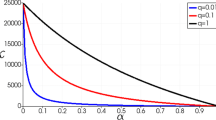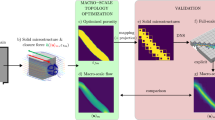Abstract
One of the current challenges for topology optimization methods is the consideration of high Reynolds fluid flow analysis, especially including turbulence models. The issues in current pseudo-density-based methods are threefold. The fluid boundaries are unknown during optimization, the convergence to \(\left\{ 0,1\right\}\) designs might be highly dependent on the tuning of the optimization parameters and it is difficult to specify the maximum value of the inverse permeability to avoid the presence of fluid flowing inside the modeled solid medium. This paper proposes a methodology to tackle these three problems. The Topology Optimization of Binary Structures (TOBS) method and a geometry trimming procedure are employed to create the TOBS-GT method. This method uses a binary \(\left\{ 0,1\right\}\) design variable, which naturally creates explicit fluid boundaries during optimization and avoids the need for tuning the material model interpolation parameters. The geometry trimming procedure removes the solid regions and create a CAD model with only the fluid analysis domain and smooth walls. Since there is no solid region inside the analysis mesh, the problem of having fluid flowing through a solid region is avoided. The k-\(\varepsilon\) and k-\(\omega\) turbulence models are chosen to illustrate that the method may be applied to any turbulence model. The equilibrium equations are solved using the finite element method. The total fluid energy dissipation is minimized considering a fluid volume constraint. Numerical results show that the TOBS-GT method is well-fitted for topology optimization of turbulent fluid flow problems.
























Similar content being viewed by others
References
Alexandersen J, Andreasen CS (2020) A review of topology optimisation for fluid-based problems. Fluids 5(5):29
Alonso DH, de Sá LFN, Saenz JSR, Silva ECN (2018) Topology optimization applied to the design of 2d swirl flow devices. Struct Multidisc Optim 58(6):2341–2364. https://doi.org/10.1007/s00158-018-2078-0
Andreasen CS, Gersborg AR, Sigmund O (2009) Topology optimization of microfluidic mixers. Int J Numer Meth Fluids 61:498–513. https://doi.org/10.1002/fld.1964
Borrvall T, Petersson J (2003) Topology optimization of fluids in Stokes flow. Int J Numer Meth Fluids 41:77–107
Brinkman HC (1947) A calculation of the viscous force exerted by a flowing fluid on a dense swarm of particles. J Appl Sci Res A1:27–34
COMSOL (2019) COMSOL multiphysics reference manual, version 5.5, COMSOL, Inc. COMSOL
Dilgen CB, Dilgen SB, Fuhrman DR, Sigmund O, Lazarov BS (2018) Topology optimization of turbulent flows. Comput Methods Appl Mech Eng 331:363–393. https://doi.org/10.1016/j.cma.2017.11.029
Dilgen SB, Dilgen CB, Fuhrman DR, Sigmund O, Lazarov BS (2018) Density based topology optimization of turbulent flow heat transfer systems. Struct Multidisc Optim 57:1905–1918. https://doi.org/10.1007/s00158-018-1967-6
Feppon F, Allaire G, Bordeu F, Cortial J, Dapogny C (2019) Shape optimization of a coupled thermal fluid-structure problem in a level set mesh evolution framework. SeMA J 76(3):413–458
Gersborg-Hansen A, Bendsøoe MP, Sigmund O (2006) Topology optimization of heat conduction problems using the finite volume method. Struct Multidisc Optim 31(4):251–259
Haftka RT, Gürdal Z (1992) Elements of structural optimization. Kluwer Academic Publishers, Dordrecht
Hyun J, Wang S, Yang S (2014) Topology optimization of the shear thinning non-Newtonian fluidic systems for minimizing wall shear stress. Comput Math Appl 67(5):1154–1170. https://doi.org/10.1016/j.camwa.2013.12.013
Jensen KE, Szabo P, Okkels F (2012) Topology optimization of viscoelastic rectifiers. Appl Phys Lett 100(23):234102:1-234102:3
Kontoleontos EA, Papoutsis-Kiachagias EM, Zymaris AS, Papadimitriou DI, Giannakoglou KC (2013) Adjoint-based constrained topology optimization for viscous flows, including heat transfer. Eng Optim 45(8):941–961
Kubo S, Koguchi A, Yaji K, Yamada T, Izui K, Nishiwaki S (2021) Level set-based topology optimization for two dimensional turbulent flow using an immersed boundary method. J Comput Phys 446:110630
Land AH, Doig AG (1960) An automatic method of solving discrete programming problems. Econometrica 28:497–520
Larsson J (1998) Numerical Simulation of Turbulent Flows for Turbine Blade Heat Transfer. PhD thesis, Chalmers University of Technology, Sweden
Lee JS, Ha MY, Min JK (2020) A finite-volume based topology optimization procedure for an aero-thermal system with a simplified sensitivity analysis method. Int J Heat Mass Transf 163:120524
Othmer C (2008) A continuous adjoint formulation for the computation of topological and surface sensitivities of ducted ows. Int J Numer Meth Fluids 58:861–877
Papoutsis-Kiachagias Giannakoglou KC (2016) Continuous adjoint methods for turbulent flows, applied to shape and topology optimization: industrial applications. Arch Comput Methods Eng 23:255–299
Paul WH (2009) Logic and integer programming, international series in operations research and management science, vol 130, 1st edn. Springer, New York. https://doi.org/10.1007/978-0-387-92280-5
Picelli R, Ranjbarzadeh S, Sivapuram R, Gioria RS, Silva ECN (2020) Topology optimization of binary structures under design-dependent fluid-structure interaction loads. Struct Multidisc Optim 62:2101–2116
Picelli R, Sivapuram R, Xie YM (2020) A 101-line MATLAB code for topology optimization using binary variables and integer programming. Struct Multidisc Optim 63:935–954
Pingen G, Maute K (2010) Optimal design for non-Newtonian flows using a topology optimization approach. Comput Math Appl 59(7):2340–2350
Pizzolato A (2018) Topology optimization for energy problems. PhD thesis, Politecnico di Torino
Romero JS, Silva ECN (2014) A topology optimization approach applied to laminar flow machine rotor design. Comput Methods Appl Mech Eng 279:268–300. https://doi.org/10.1016/j.cma.2014.06.029
Sá LF, Romero JS, Horikawa O, Silva ECN (2018) Topology optimization applied to the development of small scale pump. Struct Multidisc Optim 57(5):2045–2059. https://doi.org/10.1007/s00158-018-1966-7
Savitzky A, Golay MJE (1964) Smoothing and differentiation of data by simplified Least Squares procedures. Anal Chem 36:1627–1639
Sivapuram R, Picelli R (2018) Topology optimization of binary structures using Integer Linear Programming. Finite Elem Anal Des 139:49–61
Sivapuram R, Picelli R (2020) Topology design of binary structures subjected to design-dependent thermal expansion and fluid pressure loads. Struct Multidisc Optim 61:1877–1895
Sivapuram R, Picelli R, Xie YM (2018) Topology optimization of binary microstructures involving various non-volume constraints. Comput Mater Sci 154:405–425
Song XG, Wang L, Baek SH, Park YC (2009) Multidisciplinary optimization of a butterfly valve. ISA Trans 48(3):370–377
Souza BC, Yamabe PVM, Sá LFN, Ranjbarzadeh S, Picelli R, Silva ECN (2021) Topology optimization of fluid flow by using integer linear programming. Struct Multidisc Optim 64:1221–1240
Sá LFN, Yamabe PVM, Souza BC, Silva ECN (2021) Topology optimization of turbulent rotating flows using Spalart–Allmaras model. Comput Methods Appl Mech Eng 373:113551
Vanderbei RJ (2014) Linear programming: foundations and extensions, 4th edn. Springer, New York
Wilcox DC (1998) Turbulence modeling for CFD, 2nd edn. DCW Industries, New York
Wilcox DC (2008) Formulation of the k-omega turbulence model revisited. AIAA J 46(11):2823–2838
Yoon GH (2016) Topology optimization for turbulent flow with Spalart–Allmaras model. Comput Methods Appl Mech Eng 303:288–311. https://doi.org/10.1016/j.cma.2016.01.014
Yoon GH (2020) Topology optimization method with finite elements based on the k--ε turbulence model. Comput Methods Appl Mech Eng 361:112784. https://doi.org/10.1016/j.cma.2019.112784
Funding
This research was partly supported by CNPq (Brazilian Research Council) and FAPESP (São Paulo Research Foundation). The authors thank the supporting institutions. The first author thanks FAPESP under the Young Investigators Awards program, grants 2018/05797-8 and 2019/01685-3. The first and second authors thank FUSP (University of São Paulo Foundation), project numbers 314139 and 314137. The fourth author thanks FAPESP under grant 2017/27049-0. The last author thanks the financial support of CNPq (National Council for Research and Development) under grant 302658/2018-1 and FAPESP under grant 2013/24434-0. The authors also acknowledge the support of the RCGI (Research Centre for Gas Innovation), hosted by the University of São Paulo (USP) and sponsored by FAPESP (2014/50279-4) and Shell Brazil.
Author information
Authors and Affiliations
Corresponding author
Ethics declarations
Conflict of interest
The authors declare that they have no conflict of interest.
Replication of results
The results presented in this work can be reproduced by following the algorithms and formulations presented in detail herein. The TOBS implementation is presented in www.github.com/renatopicelli/tobs and in Picelli et al. (2020b).
Additional information
Responsible Editor: Julián Andrés Norato
Publisher's Note
Springer Nature remains neutral with regard to jurisdictional claims in published maps and institutional affiliations.
The sensitivity analysis
The sensitivity analysis
The present study adopts the adjoint sensitivity analysis via automatic differentiation to compute the sensitivity values of the fluid energy dissipation function. To verify the accuracy of this computation, the sensitivities of the pipe-bend example from Fig. 9 are compared to the finite difference method. The parameters and properties used are the same as for the pipe-bend example, except that \(\kappa _{\max} = 10^{6}\) kg/(m3 s) and Re = 2000. Fig. 25a presents the 100\(\times\)100 finite element mesh used. In the current computational set up, the density variables are defined at the nodes of the mesh. All densities are defined as \(\alpha = 1\). Figure 25b presents the volume-averaged adjoint sensitivity field computed via automatic differentiation, in 1/m\(^2\). Figure 25c presents the local fluid energy dissipation \((\mu + \mu _T) (\nabla {\varvec{v}} + (\nabla {\varvec{v}})^T)\cdot (\nabla {\varvec{v}} + (\nabla {\varvec{v}})^T)\), in W/m, clipped at 1 for better visualization. Some points inside low and high dissipation regions are chosen to compare the sensitivities against finite differences. These points, the perturbation, the computed sensitivities via the adjoint (AD) and the finite difference (FD) method and the relative errors are presented in Table 1. The errors showed to be between 0.5\(\%\) and 8.5\(\%\). Eventually, some of the errors might be caused by some terms that are ignored in the computation of the Jacobian matrix for the adjoint problem, so-called “nojac” terms by the automatic differentiation module used. Otherwise, the tolerance on the residual of the governing equations by the FEA solver can also increase the error. Anyway, in general, the sensitivities showed throughout this work to provide good directions to minimize the objective function, verified by some cross-check analyses.
Rights and permissions
About this article
Cite this article
Picelli, R., Moscatelli, E., Yamabe, P.V.M. et al. Topology optimization of turbulent fluid flow via the TOBS method and a geometry trimming procedure. Struct Multidisc Optim 65, 34 (2022). https://doi.org/10.1007/s00158-021-03118-4
Received:
Revised:
Accepted:
Published:
DOI: https://doi.org/10.1007/s00158-021-03118-4





